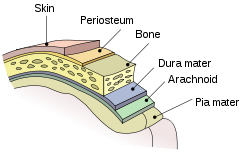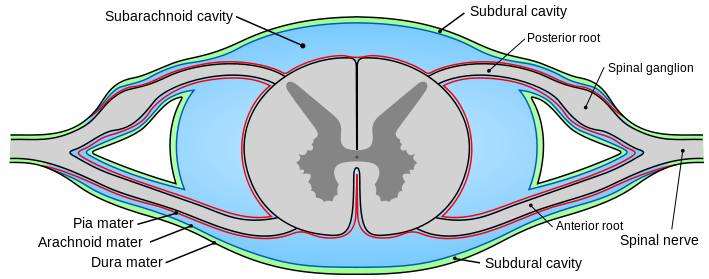|
1. Meningeal membranes
The brain and spinal cord are surrounded by membranes called the meninges, which have three layers- the (outer) dura mater, arachnoid mater and (inner) pia mater |
2. . Dura Mater
The Dura mater is a very strong fibrous membrane which is the outermost of the three layers of the meninges. On its outside it is in contact and adherent to with the bones of the skull and vertebral column. |
3. Pia Mater:
The Pia mater is the innermost of the three meninges, and is a fine memebrane found on the surface of the brain and spinal cord. Fine blood vessels run beneath the pia and branches enter the substance of the central nervous system |
4. Arachnoid Mater
The arachnoid mater is a fine membrane whose inner surface is in contact with the cerebrospinal fluid, which fills in the sub-arachnoid space. |
5. Nerves in the meninges:
The meningeal membranes are sensitive to stretch, and pain and headache are common symptoms arising from them. The sensory impulses also cause reflex spasm of neck and paravertebral muscles, which is an important sign of meningeal irritation. |
6. Blood vessels and the meninges
Blood vessels have to pass through the meninges in order to deliver blood flow to the brain. These vessels are easily ruptured as a result of head injury, and the consequences are life threatening, as in subarachnoid haemorrhage. |
7.Extra-Dural Haematoma
Blood can haemorrhage between the skull and the dura mater following head injury, stretching the meninges and causing pressure on the brain, which can be displaced and compressed. |
8. Subarachnoid Haemorrhage:
Blood sometimes appears in the CSF between the pia mater and arachnoid membranes as a result of trauma, or because of rupture of an arterial aneurysm, causing symptoms of meningeal irritation.
|


